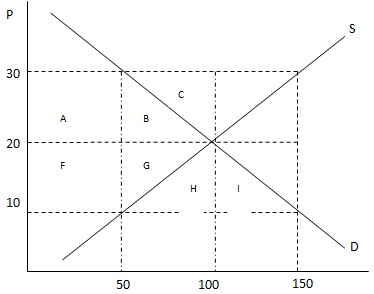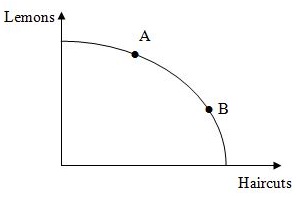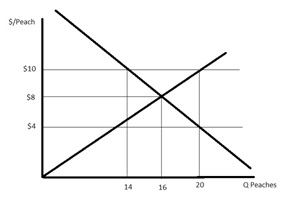Problem 1. Hotdogs and buns are complements. What will happen to the equilibrium price and quantity in the market for buns if hotdogs become less expensive? The equilibrium price for buns will
a. Increase and the equilibrium quantity will decrease.
b. Increase and the equilibrium quantity will increase.
c. Decrease and the equilibrium quantity will decrease.
d. Decrease and the equilibrium quantity will increase.
Problem 2. Which of the following statements is FALSE?
a. Good A and good B are complements. When the price of good A decreases, the demand for good B increases.
b. Good A and good B are complements. When the price of good A increases, the demand for good B decreases.
c. Good A and good B are substitutes. When the price of good A decreases, the demand for good B increases.
d. Good A and good B are substitutes. When the price of good A increases, the demand for good B increases.
Problem 3. Demand for good Z is given by
QD = 20 – P.
Income falls for individuals in this market, and demand for good Z is now given by
QD = 30 – (1/2)P.
Holding everything else constant, from this information we know that good Z is
a. A normal good
b. An inferior good
c. A complement
d. A substitute
Problem 4. Consider the guitar market. The market demand for guitars is given by P = -2Q + 12. The market supply of guitars is given by P = Q. P is price and Q is the amount of guitars. The government mandates a price floor for guitars of $6 each. Holding everything else constant, which of the following statements is true?
a. There will be a surplus of 3 guitars.
b. There will be a shortage of 3 guitars.
c. 4 guitars are traded in this market.
d. There will be no exchange of guitars in this market when this price floor is implemented.
e. Answers (b) and (c) are both correct.
Use the following diagram to answer the next two (2) questions.

Problem 5. Suppose that initially the above market is in equilibrium and the government decides to impose a minimum price of P = $30 (a price floor). The change in consumer surplus induced by this price floor policy can be measured as a(n)
a. Decrease of (area A + area B + area F + area G)
b. Decrease of (area A + area B)
c. Increase of (area F – area B)
d. Decrease of (area B + area C)
Problem 6. What is the Deadweight Loss from this new minimum price rule?
a. Area A + Area B + Area F + Area G
b. Area H + Area I
c. Area A + Area B
d. Area B + Area G
Problem 7. What is the y-intercept of the line given by the equation 20x + 40y = 10?
a. 10
b. 1/4
c. 40
d. 1
Problem 8. The following two points are on a line: (1,2) and (5,14). If there is a third point on that line (x,-7), what does x equal?
a. 2
b. -1
c. -2
d. 3
Problem 9. You read in the Friday newspaper that consumers have a linear demand for coffee mugs, wanting 50 coffee mugs at a price of $5/mug and 70 mugs at a price of $3/mug. On Sunday, however, you read that a change in preferences on Saturday has made it so consumers still have a linear demand, but want 4 fewer coffee mugs at a price of $8/mug and 12 fewer mugs at a price of $4/mug than they wanted initially. What is the new market demand equation for coffee mugs? (Hint: Although both demand curves are linear they are not necessarily parallel to one another.)
a. Q = 100 – 10P
b. Q = 100 – 1/8P
c. P = 10 – 1/10Q
d. P = 10 – 1/8Q
Problem 10. You have $2000 you must either spend on chickens ($10 each) or pigs ($60 each). If the number of chickens you buy is y and the number of pigs you buy is x, which of the following lines describes the relationship between the money you have to spend and your purchases of chickens and pigs?
a. y = 200 – 6x
b. x = 300 – 5y
c. y = 100 – 3x
d. x = 200 – 3y
Problem 11. The average of 7 numbers is 7. In addition to those 7 numbers, we now add 0, 51, and 90. What is the new average?
a. 7
b. 19
c. 20
d. 49
Use the information below to answer the next three (3) questions.
Consider a hypothetical example using the USA and China. Suppose these two countries produce two goods from their available resources: basketballs and lamps. Furthermore, assume that both countries have linear production possibility frontiers. The table below shows the maximum production levels for these two goods when each country uses all of their resources to produce just one good.
USA China
Basketballs Lamps Basketballs Lamps
100 0 300 0
0 200 0 100
Problem 12. Which of the following statements is FALSE?
a. USA has a comparative advantage in making basketballs.
b. USA has a comparative advantage in making lamps.
c. USA has an absolute advantage in making lamps.
d. China has an absolute advantage in making basketballs.
Problem 13. What is the opportunity cost of producing basketballs for the USA?
a. 2 lamps
b. 0.5 lamps
c. 0.333 lamps
d. 3 lamps
Problem 14. For what terms of trade will China and USA NOT exchange basketballs?
a. 2 lamps/basketball
b. 0.75 lamps/basketball
c. 3 lamps/basketball
d. 1.5 lamps/basketball
Problem 15. Which of following would be considered a normative statement?
a. The slope of this line is approximately 0.4.
b. The speed of light is 49 miles per hour.
c. The demand increases on average when the price drops.
d. The model should always be used to describe this situation.
Problem 16. You are trying to find the percentage of women in your class. You use a class roster to classify names as male or female. Which of the following is most likely to be a problem with the data?
a. The sample is not random because the whole class is on the roster.
b. The data is misleading on a graph because there are only two points on the x-axis: male and female.
c. There will be measurement error because some names may be difficult to classify as male or female.
d. You cannot find a percentage from the data because you can only divide by numbers, not names.
Problem 17. You won a free ticket to see Jay-Z and Kanye West perform in Chicago. The ticket has a market-value of $200 if you decide to sell it. You value seeing the concert at $400. The cost of gas and wear and tear on your car to get to and from Chicago is $50. You’re employed at the Overture Center and you were scheduled to work 6 hours at $10/hour the night of the concert (you can’t work at all if you go to the concert). You’re required to find someone to take your place if you can’t make it to work. The only person you can find who will take your place at work demands you pay him $20. What is the opportunity cost of going to the concert?
a. $130
b. $330
c. $530
d. $730
Problem 18. Use the production possibility frontier for lemons and haircuts given below to answer this question.

Which of the following is TRUE?
a. A is an inefficient production point in this economy.
b. The opportunity cost for haircuts is greater at point A than point B.
c. The opportunity cost for haircuts is greater at point B than point A.
d. B is an infeasible production point in this economy.
Use the information below to answer the following two (2) questions.
The price of hot dog buns (a complement to hot dogs) increases from $2 to $3. At the same time, the wages of the workers at the hot dog production plant decrease from $14 per hour to $10 per hour.
Problem 19. What happens to the price of hot dogs?
a. The price of hot dogs decreases.
b. The price of hot dogs increases.
c. The price of hot dogs stays the same.
d. The price of hot dogs is indeterminate.
Problem 20. What happens to the equilibrium quantity of hot dogs?
a. The quantity sold increases.
b. The quantity sold decreases.
c. The quantity sold stays the same.
d. The quantity sold is indeterminate.
Problem 21. Supply for Brewer Baseball Hats is given by Q = 10 + P. Demand for Brewer Baseball Hats is given by Q = 100 - 2P. The State of Wisconsin wants more people to sport Brewers hats and decides to offer a subsidy to induce 80 hats to be sold in the market. What is the cost of this program to the State?
a. $4800
b. $5600
c. $60
d. $1200
Problem 22. Which of following would be considered a positive question?
a. Does the university admit the right number of Minnesotans?
b. Do Minnesotans deserve an advantage in the admissions process?
c. Do Minnesotans have a statistical advantage in the admissions process?
d. Should I include State of residence when I am calculating whether or not there is discrimination in the admissions process?
Problem 23. You own a company that produces lasers. The company earns (and pays to you) a profit of $2 million per year. You are offered $10 million from investors to purchase your laser company and take over management responsibilities. You would take the $10 million and invest it in the stock market which would give you an average return of 5% per year. What is the (yearly) opportunity cost of selling the company?
a. $1,500,000 per year
b. $3,000,000 per year
c. $2,500,000 per year
d. $3,500,000 per year
Use the information below to answer the following four (4) questions.
Suppose the market for widgets in a small closed economy is initially characterized by the following domestic demand and domestic supply equations where Q is quantity and P is price.
Demand: Q = 120 – 2P
Supply: Q = 4P – 48
Problem 24. What is the equilibrium price, quantity, consumer surplus & producer surplus in the market for widgets?
a. $64, 28, $512, $1,024
b. $28, 64, $2,048, $1,024
c. $28, 64, $1,024, $512
d. $64, 28, $1,024, $2,048
Problem 25. Suppose demand increases by 12 units at any given price. Holding everything else constant, what is the new value of consumer surplus?
a. $1,156
b. $1,296
c. $1,368
d. $2,592
26. Using the original supply and demand given above, now suppose the world price for widgets is $24. Suppose this small economy opens up its widget market to international trade, but sets an import quota of 12 widgets. What is the new price for widgets in the small economy?
a. $22
b. $24
c. $26
d. $28
Problem 27. Again using the original supply and demand given above, now suppose the world price for widgets is $24. Suppose this small economy instead of implementing a quota implements an import tariff of $4 to each widget imported. What would be the deadweight loss associated with this tariff as compared to an open market for widgets without trade restrictions?
a. $48
b. $96
c. $24
d.$16
Problem 28. Wisconsin farmers lobby for a price support of $9/pumpkin. Supply of pumpkins is given by Q = 5P - 10. Demand is Q = -6P + 67. The state makes excess pumpkins into pies to be given away for free to the homeless at a cost to the state of $1/pumpkin. How much does this price support program cost the State? In your calculation include the cost to the state of both purchasing the pumpkins as well as making them available as pies to the homeless.
a. $117
b. $198
c. $220
d. $175
Use the following diagram to answer the next three (3) questions.

Problem 29. What is the consumer surplus in the free-market for peaches?
a. $160
b. $32
c. $128
d. $98
Problem 30. Now, if the government institutes a price support equal to $10/peach, what is the consumer surplus in the market for peaches?
a. $49
b. $98
c. $256
d. $48
Problem 31. If the government uses a price support program to implement the price floor of $10/peach, what is the total cost to the government? Assume there is no storage cost to the government for this program.
a. $60
b. $96
c. $70
d. $100
Problem 32. Suppose there are only two customers in the market for Duct Tape and their individual demand curves are given as follows:
Dexter’s demand for Duct Tape: QD = 5 - PD
Patrick’s demand for Duct Tape: PD = 7 - QD
ShurTech is the only manufacturer of Duct Tape and their supply curve is as follows:
ShurTech’s supply of Duct Tape: QS = 8PS - 8
Given this information, what is the market equilibrium price of Duct Tape?
a. $1.00
b. $2.00
c. $3.00
d. $4.00
Problem 33. A massive tornado tears through southwest Wisconsin destroying 1,500 acres of farmland used to grow corn. Holding everything else constant, what does this do to the supply and demand of corn?
a. The demand shifts left which causes a downward movement in the price of corn.
b. The demand shifts right which causes a downward movement in the price of corn.
c. The supply shifts right which causes an upward movement in the price of corn.
d. The supply shifts left which causes an upward movement in the price of corn.